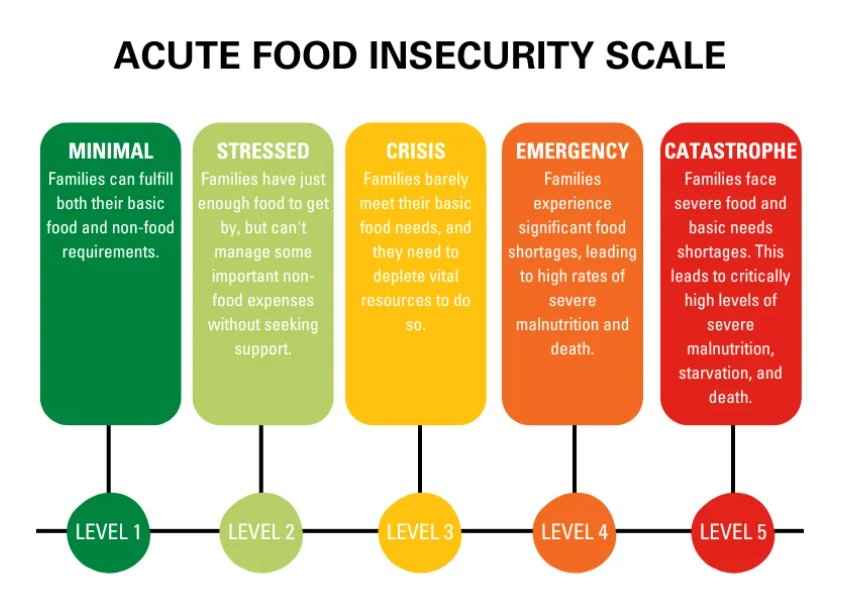At A Glance :
• Famine has been declared in a displacement camp in Sudan by the Famine Review Committee
• Experts believe that famine will soon be declared in Gaza
• Famine is extreme food deprivation, leading to malnutrition and death from starvation
• Famine can be avoided if we act before a population hits the worst-case scenario.
United Nations officials have officially declared famine in Sudan, while famine continues to remain imminent in Gaza, with widespread conflict in both regions driving a catastrophic hunger crisis amongst civilians.
It’s alarming news, but what does it actually mean? And how is famine different from other terms we might come across in the news, like ‘food insecurity’? Here’s a quick explainer on how a famine is declared, why it’s happening in certain parts of the world, and what you can do about it.
What Is Famine?
Famine is when a population of people is extremely deprived of food, and experiences widespread malnutrition, destitution, and death from starvation. The Integrated Security Phase Classification (IPC) classifies a region in famine when:
- 20 per cent of households in the region face an extreme lack of food;
- 30 per cent of children suffer from acute malnutrition; and
- Two adults or four children for every 10,000 people are dying each day from starvation.
Famine is different from food insecurity, which is when families don’t have regular access to enough nutritious food to develop, grow, and be active and healthy. While people experience food insecurity at different levels, acute food insecurity is when lack of food—usually caused by a major shock such as a flood, economic collapse, or conflict—puts a person’s life or livelihood in immediate danger.
Famine is an extreme form of acute food insecurity. At this point, food is so scarce that many people face death by starvation.
How Is A Famine Declared?
The United Nations initially developed the IPC in response to the 2004 famine in Somalia. Today, it’s a multi-partner system that analyses data from food-insecure regions, such as the average calorie intake, how accessible food is, coping strategies households rely on (e.g. skipping meals so children can eat), and malnutrition in children.
The data is then used to classify a population into one of five categories, ranging from phase one (no stress in accessing food) through to phase four (emergency levels of food insecurity).

Phase five is famine, the worst-case scenario. When a population reaches this phase and meet the criteria of a famine, the government of the affected country and UN agencies are likely to declare a famine.
What Causes Famine?
Many of us think of drought when we hear the word ‘famine’, but lots of situations can cause catastrophic levels of food insecurity, such as a natural hazard, animal diseases, crop pests, or economic crisis.
One of the most common causes, though, is conflict. Large-scale violence displaces entire communities, making it hard to produce food. Conflict also destroys infrastructure, market centres and transport routes—things that are critical for food distribution in a community.
Two regions where this is happening right now is Sudan and Gaza.
One third of Sudan at risk of starvation.
Famine has officially been declared in the Sudanese city, El Fasher, where around 600,000 displaced people are living.
Sudan has experienced an unprecedented displacement crisis since military conflict began in April 2023, with over 10.7 million people forced to flee their homes. The chaos of displacement, combined with soaring food prices and below average agriculture production, has led to acute food insecurity for close to 18 million people—a third of the country’s population.
In some reports, people are queuing for hours to receive just one meal a day from humanitarian agencies struggling to transport food. If things continue, humanitarian experts predict that 230,000 children, pregnant women and new mothers could die from malnutrition in the coming months.
Famine any day now in Gaza
The IPC has found that 2.15 million people in Gaza—half the population—are experiencing catastrophic food insecurity, with all supplies exhausted and aid organisations struggling to get enough food to civilians amidst hostilities.
According to the latest reports, one in three children under two years old in northern Gaza are acutely malnourished and dangerously thin for their height, and two-thirds of households are going entire days and nights without eating. The IPC predicts that the north of Gaza will be classified as in a state of famine at any day now, with the southern governates also at risk of falling into famine.
What Can We Do About Famine?
Identifying a famine shows where the most urgent needs are, so aid agencies and governments can make informed decisions about allocating resources.
But the goal isn’t to wait for a famine declaration before providing help; it’s to avoid famine altogether. By measuring food insecurity, the IPC sounds an alarm before a country hits crisis-point, so that the international community can act to prevent a worst-case scenario. Speaking about food insecurity in Gaza, World Food Programme Executive Director Cindy McCain said, ‘if we wait until famine has been declared, it’s too late. Thousands more will be dead.’
Baptist World Aid’s Christian Partners are serving in places facing acute food insecurity.
Through the Hunger Crisis Appeal, we’re helping families access and produce nutritious food so people don’t die from starvation, and children can grow to be healthy and strong.
You can help families survive food insecurity by giving to our Hunger Crisis Appeal. Your gift will help provide access to critically needed food as well as addressing other needs exacerbated by food insecurity.



